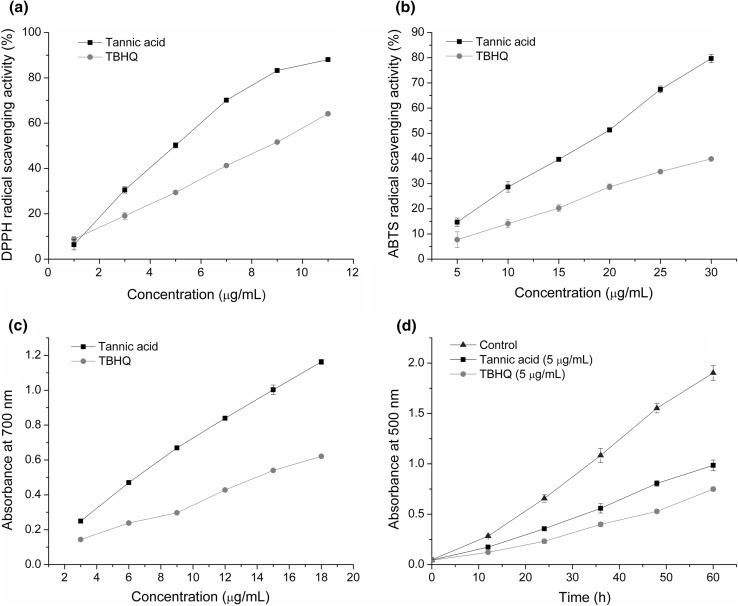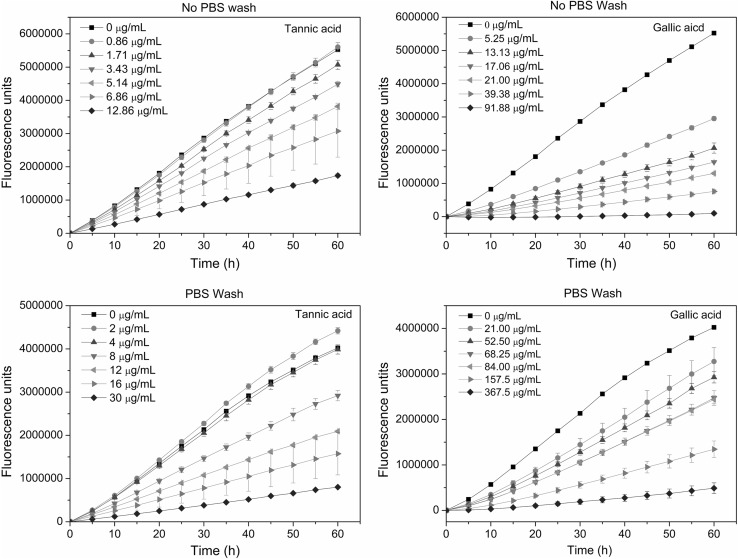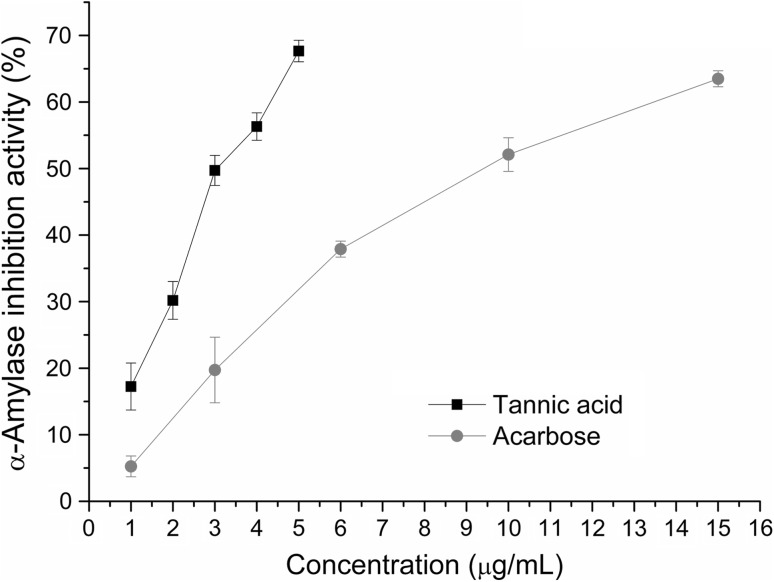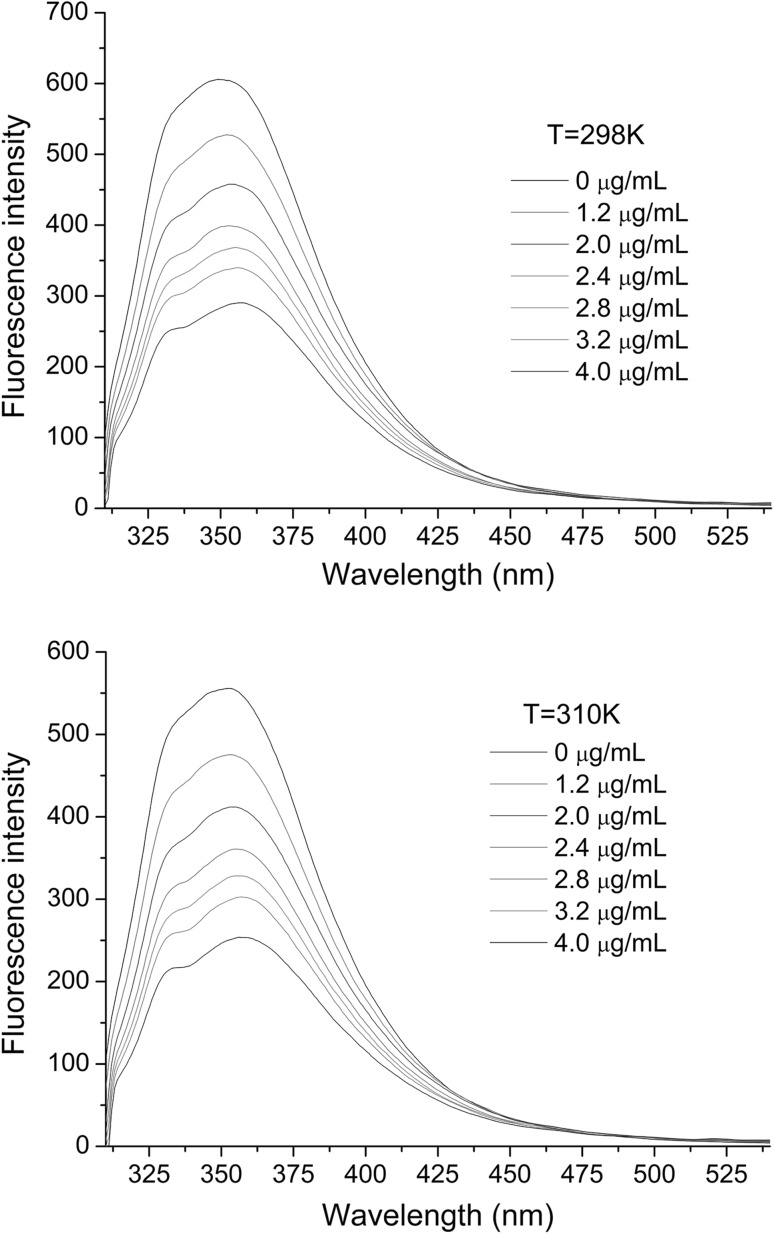Abstract
Tannic acid widely exists in plants, which forms a part of human diet. The antioxidant activity of tannic acid was evaluated by the chemical and cellular antioxidant assays. And its α-amylase inhibitory activity and behavior were also investigated. It was found that hydrogen- and electron donating capacities of tannic acid were higher than those of tertiary butylhydroquinone (TBHQ) based on reducing power, ABTS and DPPH radical scavenging assays. But for its low hydrophobic property, the antioxidant activity of tannic acid in linoleic acid system was inferior to that of TBHQ. In the cellular antioxidant assay, tannic acid showed the higher activity than gallic acid in the “PBS wash” protocol, which could attribute to its high binding capacity of cell membrane. Compared with acarbose, tannic acid possessed the stronger α-amylase inhibitory capacity. And the static fluorescence quenching of α-amylase in the presence of tannic acid could be also observed, which was caused by their binding interaction.
Keywords: Tannic acid, Cellular antioxidant, α-amylase inhibitory, Interaction
Introduction
Polyphenols widely exist in teas, fruits and medicinal plants, which form a part of human diet. It is believed that the enough intake of polyphenol-rich plant foods can reduce the risk of diabetes, hypertension, obesity and cancers (Gajaria et al. 2015; Baharfar et al. 2015; Ruel et al. 2013), which can be partly explained by the strong antioxidant and enzyme inhibitory activities of polyphenols (Cuevas-Juárez et al. 2014; Ali et al. 2011; Girish et al. 2012). Tannins are also a kind of polyphenols in plants, which include two categories: hydrolysable tannin and condensed tannin. The former could be regarded as the polymer of gallic acid or ellagic acid while the latter is the polycondensate of flavanol (Arapitsas 2012). For its astringency or puckery taste, tannins are often identified as the “undesired” ingredient in plant foods by the consumers (Jauregi et al. 2016). Today, tannins are receiving more and more attention for its ubiquitous existence in plant foods and potential bioactivities (Figueroa-Espinoza et al. 2015; Ricci et al. 2016; Karamać 2010). It was found that the hydrolyzable tannins from the fruits of Terminalia chebula Retz possessed the potent α-glucosidase inhibitory activity (Lee et al. 2017). Xiao et al. (2015) evaluated the α-glucosidase and trypsin inhibitory activities of tannic acid. And the ellagitannins could be related to the fight and prevention of oxidative related diseases (Larrosa 2010). But compared with the small polyphenols such flavonoids and phenolic acids, the research about the bioactivities of tannins is still insufficient, which could limit our understanding about their potential functions in foods. In view of this, the antioxidant activities of tannic acid, a kind of commercial tannin, were systematically evaluated by the chemical and cellular antioxidant assays. And its α-amylase inhibitory activity and behavior were also investigated.
Materials and methods
Chemicals
2′-Azobis-amidinopropane (AAPH), dichlorofluorescin diacetate (DCFH-DA), 2,2-dipheny-l-picrylhydrazyl (DPPH), pancreatic α-amylase, quercetin, linoleic acid, soluble starch, gallic acid and 2,2′-azino-bis(3-ethylbenzothiazoline-6-sulfonic acid) diammonium salt (ABTS) were the products of Sigma (St. Louis, MO, USA). Tertiary butylhydroquinone (TBHQ) and tannic acid were purchased from Aladdin (Shanghai, China). HepG2 cell line was from American Type Culture Collection (Rockville, MD). Williams’ medium E, heparin and insulin were obtained from Gibco. All other chemicals were of analytical grade.
DPPH radical scavenging assay
The DPPH radical scavenging activities of tannic acid and TBHQ were measured by using a published method (Wang et al. 2015). Briefly, the ethanol solution of the sample (2 mL) at different concentrations and DPPH ethanol solution (2 mL, 2 × 10−4 mol/L) were mixed and incubated for 30 min at room temperature. Then the absorbance of the sample (ASample) was read at 517 nm by using a UNICO spectrometer (Shanghai, China). The absorbance of the control (AControl) containing ethanol instead of the sample was also measured at the same experimental conditions. In the end, the DPPH radical scavenging activity of the sample could be calculated according to the following equation:
ABTS radical scavenging assay
The ABTS radical scavenging assay of tannic acid and TBHQ was performed according to a published method (Zhu et al. 2011). The aqueous solution of sample (0.15 mL) at different concentrations was mixed with the ABTS solution (2.85 mL). After incubated for 10 min, the absorbance of the obtained mixture (ASample) at 734 nm was determined by a UNICO spectrometer (Shanghai, China). The absorbance of the control (AControl) containing water instead of the sample was also measured under the same conditions. And the ABTS radical scavenging activity of the sample was obtained from the following equation:
Reducing power assay
The evaluation of reducing power of tannic acid and TBHQ was carried out by using the reported method (Chen et al. 2016). 0.5 mL of the sample at different concentrations, 2.5 mL of PBS (0.2 mol/L, pH 6.6) and 2.5 mL of 1% K3Fe(CN)6 were mixed and incubated at 50 °C for 20 min. The cooled solution was mixed with 2.5 mL of 10% TCA (trichloroacetic acid) and centrifuged at 3000 rpm for 10 min. 0.5 mL of 0.1% FeCl3 and 2.5 mL of water were added to the supernatant (2.5 mL). Then, the absorbance of the obtained solution at 700 nm was measured by a UNICO spectrometer (Shanghai, China), which represented the reducing power of the sample at certain concentration.
Antioxidant assay in linoleci acid system
The antioxidant activities of tannic acid and TBHQ in linoleic acid were determined to reflect their antioxidant capacities in the lipophilic system according to the previous study (Sakanaka et al. 2004). 0.2 mL of the sample at 5 μg/mL, 2 mL of 2.5% linoleic acid in ethanol, 4 mL of PBS (0.05 M, pH 7.0) and 4 mL of water were mixed and kept at 40 °C for 30 min. The oxidation of linoleic acid was determined at the interval of 12 h according to the ferric thiocyanate method. Briefly, the reaction solution (0.1 mL), 30% ammonium thiocyanate (0.1 mL), 75% ethanol (8 mL) and 20 mM FeCl2 (0.1 mL) were mixed. Then, its absorbance at 500 nm was measured, which reflected the oxidation degree of linoleic acid.
Cellular antioxidant assay
The cellular antioxidant activities of tannic acid and gallic acid were evaluated by using a published method (Chen et al. 2015). HepG2 cells were incubated on a 96-well microplate at 37 °C for 24 h with the cell density of 6 × 104/well and the growth medium addition of 100 μL/well. After the growth medium in the wells was replaced by 100 μL of the growth medium containing tannic acid and 50 μM DCFH-DA, the cells were incubated for 1 h. Then, two protocols were carried out. For the “no PBS wash” protocol, 600 μM AAPH was directly added to the wells containing the cells and tannic acid. For the “PBS wash” protocol, before 600 μM AAPH was added, the growth medium with tannic acid was replaced with 100 μL PBS. The fluorescent data of each well at the emission wavelength of 535 nm and the excitation wavelength of 485 nm was collected and processed to obtain the EC50 value and CAA value (μmol of quercetin/100 g of sample).
α-Amylase inhibition assay
The α-amylase inhibitory activity of tannic acid with acarbose as the positive control was determined according to the procedure described with some modification (Ranilla et al. 2010). Briefly, 0.3 mL of the sample at different concentrations and 1 mL of 15 μg/mL pancreatic α-amylase in 0.1 M PBS (pH 6.8) were mixed and kept at 37 °C for 30 min. Then, 1.5 mL of dinitrosalicylic acid colour reagent was added the reaction solution. The obtained mixture was incubated in a boiling water bath for 15 min. After the mixture was cooled to room temperature, its absorbance at 540 nm was read as ASample. And the absorbance of the control (AControl) containing water instead of the sample was also measured under the same conditions. And the α-amylase inhibition activity of the sample could be obtained from the following formula:
Binding evaluation of tannic acid and α-amylase
The binding behavior of tannic acid to α-amylase was evaluated by spectrofluorimetry. 4 mL of α-amylase solution (0.5 mg/mL) and 1 mL of tannic acid at different concentrations were mixed and incubated for 20 min at 25 and 37 °C. Then the fluorescence spectrum was recorded on a Cary Eclipse fluorimeter (Agilent, USA) with the excitation wavelength at 295 nm and the emission wavelength in the range of 330–550 nm. Both the excitation and emission slit widths were set at 5 nm.
Statistical analysis
The results of three replicates were expressed as mean ± SD. The Student’s t test was applied for the statistical comparison. And the p value of < 0.05 was considered to be significant.
Results and discussion
Chemical antioxidant activity
The chemical antioxidant activity of tannic acid was evaluated with TBHQ as the positive control in this study, which is a kind of synthetic antioxidant and widely applied in food industry (Zhao et al. 2017). In order to give the better understand of the antioxidant functions of tannic acid, four authoritative antioxidant assays were carried out, which were commonly used for antioxidant evaluation of plant components (Zou et al. 2004). The DPPH and ABTS radical scavenging assays were applied to reflect the H-donating capacity of the sample. It was found that the IC50 values of the DPPH and ABTS radical scavenging activities of tannic acid were 4.87 and 18.68 μg/mL, respectively. And the corresponding IC50 values of TBHQ were 8.63 and > 30 μg/mL, respectively (Fig. 1). The H-donating capacity of tannic acid was higher than that of TBHQ. The reducing power assay could represent the electron-donating ability of the sample. As show in Fig. 1, the linear relationship between the concentration of the tested sample and reducing power could be found. And the performance of tannic acid was superior to that of TBHQ. But the antioxidant activity of tannic acid in the linoleic acid system was significantly inferior to that of TBHQ. It could be referred that the galloyl groups of tannic acid could lead to its strong hydrogen- and electron- donating capacities. But the poor hydrophobic property of tannic acid resulted in its low antioxidant activity of tannic acid in linoleic acid system.
Fig. 1.
Chemical antioxidant activities of tannic acid and TBHQ. a DPPH radical scavenging activity, b ABTS radical scavenging activity, c Reducing power, d antioxidant activity in linoleic acid system)
Cellular antioxidant activity
The traditional antioxidant assays measure the antioxidant activity of the sample in the chemical models, which fail to reflect its actual antioxidant activity in vivo and bioavailability (Wolfe et al. 2008). As a result, the cellular antioxidant activity was established by using the HepG2 cell line. And the results could be expressed as EC50 value inhibiting peroxyl radical-induced oxidation and CAA value. The lower EC50 value or higher CAA value means the stronger cellular antioxidant activity. In this study, the cellular antioxidant activities of tannic acid and gallic acid were compared in the “PBS wash” and “no PBS wash” protocols (Fig. 2). It was found that the performance of gallic acid in “no PBS wash” protocol with the EC50 value of 5.61 ± 0.59 μg/mL and CAA value of 189,089.21 ± 19,906.49 μmol quercetin/100 g sample was superior to that of tannic acid with the EC50 value of 7.80 ± 0.12 μg/mL and CAA value of 135,065.26 ± 2159.91 μmol quercetin/100 g sample, which suggested that gallic acid possessed the higher overall antioxidant activity in the test system. Compared with the “no PBS wash” protocol, the “PBS wash” protocol can reflect the intracellular antioxidant activity of the tested bioactive compounds (Wolfe and Liu 2007). And in this protocol, the antioxidant activity of tannic acid (EC50, 13.19 ± 0.82 μg/mL; CAA, 101,734.35 ± 6099.02 μg/mL) was higher than that of gallic aicd (EC50, 65.83 ± 4.32 μg/mL; CAA, 20,387.27 ± 1296.28 μg/mL), which suggest that compared with gallic acid, tannic acid as the polymer of gallic aicd had the higher intracellular antioxidant activity. In our previous study, we also found the cellular antioxidant activity the polymer of catechin and glyoxylic acid in was higher than that of catechin in the “PBS wash” protocol (Geng et al. 2016), which coincided with the result in this study. This phenomenon could be explained by the improvement of binding capacity of cell membrane, which was caused by the polymerization.
Fig. 2.
Peroxyl radical-induced oxidation of DCFH to DCF in HepG2 cells and the inhibition of oxidation over time by tannic acid and gallic acid
α-Amylase inhibitory activity
The salivary and pancreatic α-amylases usually account for the digestion of food starch in the human body, which have the significant impact on the blood glucose level (Oboh and Ademosun 2011). And many synthetic medicines (such as acarbose and voglibose) for the management of type-2 diabetes have the α-amylase inhibitory capacities (Xiao and Högger 2015). For the potential toxicity and side effect of these synthetic drugs, the requirements for the natural α-amylase inhibitors are increasing (Yao et al. 2013; Liu et al. 2013). Although tannic acid widely exists in plants, there were few reports about its α-amylase inhibitory activity. As shown in Fig. 3, the α-amylase inhibitory activity of tannic acid was measured with acarbose as the positive control. And the α-amylase inhibitory activity was superior to that of acarbose. The IC50 values of tannic acid and acarbose were 3.46 and 10.40 μg/mL, respectively. It was reported that the longan pericarp proanthocyanidins containing dominant catechin/epicatechin units with a mean degree of polymerisation of 3.3 was a strong α-amylase inhibitor with the IC50 of 75 μg/mL (Fu et al. 2015). But the α-amylase inhibitor performance (IC50, 554.4 g/mL) of sorghum condensed tannins (Links et al. 2015) was far lower than that of our result, which could be due to the higher degree of polymerization of tannic acid.
Fig. 3.
α-Amylase inhibitory activities of tannic acid and acarbose
In order to investigate the binding behavior, the effect of tannic acid on the fluorescence spectrum of α-amylase at 25 and 37 °C were measured (Fig. 4). With the increase of the concentration of tannic acid ([Q]), the intrinsic fluorescence intensity (F) of α-amylase gradually decreased. The quenching constants between tannic acid and α-amylase at 25 and 37 °C could be obtained based on the following Stern–Volmer equation (Li et al. 2009):
Fig. 4.
Effect of tannic acid on fluorescence spectrum of α-amylase at 298 and 310 K
τ0 is the average life of fluorescent substance without quencher, valued about 10−8 s (Li et al. 2009). Both the quenching constants (Kq) at 25 °C (4.556 × 1013 L mol−1 s−1) and 37 °C (4.172 × 1013 L mol−1 s−1) were higher than 2 × 1010, which was the maximum quenching constant for the dynamic quenching. It could be concluded that the fluorescence quenching of α-amylase belonged to the static quenching caused by the formation of its complex with tannic acid. And the binding constants (Ka) and the number of binding site (n) between tannic acid and α-amylase could be calculated according to the double-logarithm equation (Yang et al. 2016):
The binding constant (Ka) at 37 °C (4.23202 × 109 L mol−1) was inferior to that at 25 °C (4.60628 × 109 L mol−1), which suggested the binding interaction of α-amylase with tannic acid led to its fluorescence quenching since the increasing temperature could have the negative effect on the stability of the complex. And the number of binding sites at 25 and 37 °C were 1.7043 and 1.6915, respectively. It could be concluded that they could bind at the molar ratio of 2, which should attribute to the large volume of tannic acid.
Conclusion
Compared with TBHQ, tannic acid possessed the stronger reducing power, DPPH and ABTS radical scavenging activities while its antioxidant activity in linoleic acid system was inferior to that of TBHQ. The cellular antioxidant activity of tannic acid was superior to that of gallic acid in the “PBS wash” protocol, which could attribute to its high binding capacity of cell membrane. And the α-amylase inhibitory activity of tannic acid was superior to that of acarbose. The static fluorescence quenching of α-amylase could be also observed, which was caused by its binding interaction with tannic acid. In view of the ubiquitous existence of tannic acid in plants, our results can be helpful to understand the antioxidant and anti-diabetes functions of the plant foods.
Acknowledgements
This research was supported by the National Natural Science Foundation of China (Nos. 31771941 and 31571782), the Program for Science & Technology Innovation Talents in Universities of Henan Province (No. 14HASTIT019), Henan Research Program of Foundation and Advanced Technology (No. 162300410177) and the Major Science and Technology Project in Henan (No. 161100110600).
References
- Ali KM, Chatterjee K, De D, Jana K, Bera TK, Ghosh D. Inhibitory effect of hydro-methanolic extract of seed of Holarrhena antidysenterica on alpha-glucosidase activity and postprandial blood glucose level in normoglycemic rat. J Ethnopharmacol. 2011;135:194–196. doi: 10.1016/j.jep.2011.02.034. [DOI] [PubMed] [Google Scholar]
- Arapitsas P. Hydrolyzable tannin analysis in food. Food Chem. 2012;135:1708–1717. doi: 10.1016/j.foodchem.2012.05.096. [DOI] [PubMed] [Google Scholar]
- Baharfar R, Azimi R, Mohseni M. Antioxidant and antibacterial activity of flavonoid-, polyphenol-and anthocyanin-rich extractsfrom Thymus kotschyanus boiss & hohen aerial parts. J Food Sci Technol. 2015;52:6777–6783. doi: 10.1007/s13197-015-1752-0. [DOI] [PMC free article] [PubMed] [Google Scholar]
- Chen Y, Chen G, Fu X, Liu RH. Phytochemical profiles and antioxidant activity of different varieties of Adinandra Tea (Adinandra Jack) J Agric Food Chem. 2015;63:169–176. doi: 10.1021/jf503700v. [DOI] [PubMed] [Google Scholar]
- Chen Y, Zhang R, Liu C, Zheng X, Liu B. Enhancing antioxidant activity and antiproliferation of wheat bran through steam flash explosion. J Food Sci Technol. 2016;53:3028–3034. doi: 10.1007/s13197-016-2274-0. [DOI] [PMC free article] [PubMed] [Google Scholar]
- Cuevas-Juárez E, Yuriar-Arredondo KY, Pío-León JF, Montes-Avila J, López-Angulo G, Díaz-Camacho SP. Antioxidant and α-glucosidase inhibitory properties of soluble melanins from the fruits of Vitex mollis Kunth, Randia echinocarpa Sessé et Mociño and Crescentia alata Kunth. J Funct Foods. 2014;9:78–88. doi: 10.1016/j.jff.2014.04.016. [DOI] [Google Scholar]
- Figueroa-Espinoza MC, Zafimahova A, Alvarado PG, Dubreucq E, Poncet-Legrand C. Grape seed and apple tannins: emulsifying and antioxidant properties. Food Chem. 2015;178:38–44. doi: 10.1016/j.foodchem.2015.01.056. [DOI] [PubMed] [Google Scholar]
- Fu C, Yang X, Lai S, Liu C, Huang S, Yang H. Structure, antioxidant and α-amylase inhibitory activities of longan pericarp proanthocyanidins. J Funct Foods. 2015;14:23–32. doi: 10.1016/j.jff.2015.01.041. [DOI] [Google Scholar]
- Gajaria TK, Patel DK, Devkar RV, Ramachandran AV. Flavonoid rich extract of Murraya Koenigii alleviates in vitro LDL oxidation and oxidized LDL induced apoptosis in raw 264.7 Murine macrophage cells. J Food Sci Technol. 2015;52:3367–3375. doi: 10.1007/s13197-014-1399-2. [DOI] [PMC free article] [PubMed] [Google Scholar]
- Geng S, Shan S, Ma H, Liu B. Antioxidant activity and α-glucosidase inhibitory activities of the polycondensate of catechin with glyoxylic acid. PLoS ONE. 2016;11:e0150412. doi: 10.1371/journal.pone.0150412. [DOI] [PMC free article] [PubMed] [Google Scholar]
- Girish TK, Pratape VM, Prasada Rao UJS. Nutrient distribution, phenolic acid composition, antioxidant and alpha-glucosidase inhibitory potentials of black gram (Vigna mungo L.) and its milled by-products. Food Res Int. 2012;46:370–377. doi: 10.1016/j.foodres.2011.12.026. [DOI] [Google Scholar]
- Jauregi P, Olatujoye JB, Cabezudo I, Frazier RA, Gordon MH. Astringency reduction in red wine by whey proteins. Food Chem. 2016;199:547–555. doi: 10.1016/j.foodchem.2015.12.052. [DOI] [PubMed] [Google Scholar]
- Karamać M. Antioxidant activity of tannin fractions isolated from buckwheat seeds and groats. J Am Oil Chem Soc. 2010;87:559–566. doi: 10.1007/s11746-009-1525-x. [DOI] [Google Scholar]
- Larrosa M, García-Conesa MT, Espín JC, Tomás-Barberán FA. Ellagitannins, ellagic acid and vascular health. Mol Asp Med. 2010;31:513–539. doi: 10.1016/j.mam.2010.09.005. [DOI] [PubMed] [Google Scholar]
- Lee DY, Kim HW, Yang H, Sung SH. Hydrolyzable tannins from the fruits of Terminalia chebula Retz and their α-glucosidase inhibitory activities. Phytochemistry. 2017;137:109–116. doi: 10.1016/j.phytochem.2017.02.006. [DOI] [PubMed] [Google Scholar]
- Li YQ, Zhou FC, Gao F, Bian JS, Shan F. Comparative evaluation of quercetin, isoquercetin and rutin as inhibitors of α-glucosidase. J Agric Food Chem. 2009;57:11463–11468. doi: 10.1021/jf903083h. [DOI] [PubMed] [Google Scholar]
- Links MR, Taylor J, Kruger MC, Taylor JRN. Sorghum condensed tannins encapsulated in kafirin microparticles as a nutraceutical for inhibition of amylases during digestion to attenuate hyperglycaemia. J Funct Foods. 2015;12:55–63. doi: 10.1016/j.jff.2014.11.003. [DOI] [Google Scholar]
- Liu S, Li D, Huang B, Chen Y, Lu X, Wang Y. Inhibition of pancreatic lipase, α-glucosidase, α-amylase, and hypolipidemic effects of the total flavonoids from Nelumbo nucifera leaves. J Ethnopharmacol. 2013;149:263–269. doi: 10.1016/j.jep.2013.06.034. [DOI] [PubMed] [Google Scholar]
- Oboh G, Ademosun AO. Shaddock peels (Citrus maxima) phenolic extracts inhibit α-amylase, α-glucosidase and angiotensin I-converting enzyme activities: a nutraceutical approach to diabetes management. Diabetes Metab Syndr Clin Res Rev. 2011;5:148–152. doi: 10.1016/j.dsx.2012.02.008. [DOI] [PubMed] [Google Scholar]
- Ranilla LG, Kwon YI, Apostolidis E, Shetty K. Phenolic compounds, antioxidant activity and in vitro inhibitory potential against key enzymes relevant for hyperglycemia and hypertension of commonly used medicinal plants, herbs and spices in Latin America. Bioresour Technol. 2010;101:4676–4689. doi: 10.1016/j.biortech.2010.01.093. [DOI] [PubMed] [Google Scholar]
- Ricci A, Lagel MC, Parpinello GP, Pizzi A, Kilmartin PA, Versari A. Spectroscopy analysis of phenolic and sugar patterns in a food grade chestnut tannin. Food Chem. 2016;203:425–429. doi: 10.1016/j.foodchem.2016.02.105. [DOI] [PubMed] [Google Scholar]
- Ruel G, Lapointe A, Pomerleau S, Couture P, Lemieux S, Lamarche B, Couillard C. Evidence that cranberry juice may improve augmentation index in overweight men. Nutr Res. 2013;33:41–49. doi: 10.1016/j.nutres.2012.11.002. [DOI] [PubMed] [Google Scholar]
- Sakanaka S, Tachibana Y, Ishihara N, Juneja LR. Antioxidant activity of egg-yolk protein hydrolysates in a linoleic acid oxidation system. Food Chem. 2004;86:99–103. doi: 10.1016/j.foodchem.2003.08.014. [DOI] [Google Scholar]
- Wang K, Wang Y, Lin S, Liu X, Yang S, Jones GS. Analysis of DPPH inhibition and structure change of corn peptides treated by pulsed electric field technology. J Food Sci Technol. 2015;52:4342–4350. doi: 10.1007/s13197-014-1450-3. [DOI] [PMC free article] [PubMed] [Google Scholar]
- Wolfe KL, Liu RH. Cellular antioxidant activity (CAA) assay for assessing antioxidants, foods, and dietary supplements. J Agric Food Chem. 2007;55:8896–8907. doi: 10.1021/jf0715166. [DOI] [PubMed] [Google Scholar]
- Wolfe KL, Kang X, He X, Dong M, Zhang Q, Liu RH. Cellular antioxidant activity of common fruits. J Agric Food Chem. 2008;56:8418–8426. doi: 10.1021/jf801381y. [DOI] [PubMed] [Google Scholar]
- Xiao JB, Högger P. Dietary polyphenols and type 2 diabetes: current insights and future perspectives. Curr Med Chem. 2015;22:23–38. doi: 10.2174/0929867321666140706130807. [DOI] [PubMed] [Google Scholar]
- Xiao H, Liu B, Mo H, Liang G. Comparative evaluation of tannic acid inhibiting α-glucosidase and trypsin. Food Res Int. 2015;76:605–610. doi: 10.1016/j.foodres.2015.07.029. [DOI] [PubMed] [Google Scholar]
- Yang L, Yu W, Li Z, Zhang X, Ren T, Zhang L, Wang R, Chang J. Comparative study of the binding between FTO protein and five pyrazole derivatives by spectrofluorimetry. J Mol Liq. 2016;218:156–165. doi: 10.1016/j.molliq.2016.02.031. [DOI] [Google Scholar]
- Yao X, Zhu L, Chen Y, Tian J, Wang Y. In vivo and in vitro antioxidant activity and α-glucosidase, α-amylase inhibitory effects of flavonoids from Cichorium glandulosum seeds. Food Chem. 2013;139:59–66. doi: 10.1016/j.foodchem.2012.12.045. [DOI] [PubMed] [Google Scholar]
- Zhao X, Wu S, Gong G, Li G, Zhuang L. TBHQ and peanut skin inhibit accumulation of PAHs and oxygenated PAHs in peanuts during frying. Food Control. 2017;75:99–107. doi: 10.1016/j.foodcont.2016.12.029. [DOI] [Google Scholar]
- Zhu KX, Lian CX, Guo XN, Peng W, Zhou HM. Antioxidant activities and total phenolic contents of various extracts from defatted wheat germ. Food Chem. 2011;126:1122–1126. doi: 10.1016/j.foodchem.2010.11.144. [DOI] [Google Scholar]
- Zou Y, Lu Y, Wei D. Antioxidant activity of a flavonoid-rich extract of Hypericum perforatum L. in vitro. J Agric Food Chem. 2004;52:5032–5039. doi: 10.1021/jf049571r. [DOI] [PubMed] [Google Scholar]






